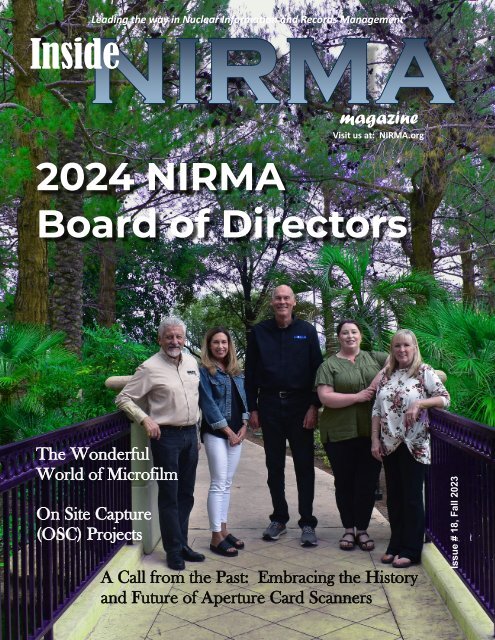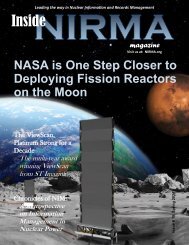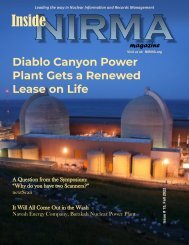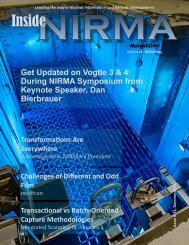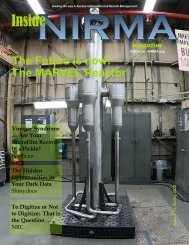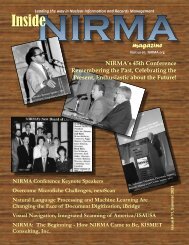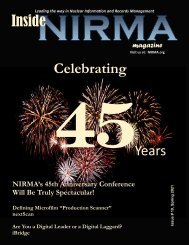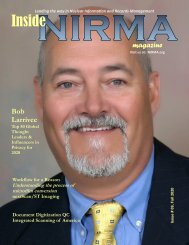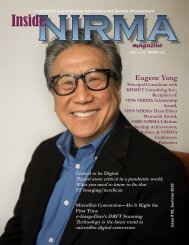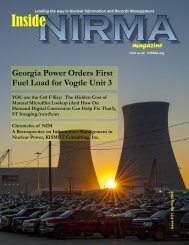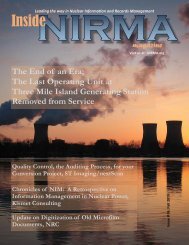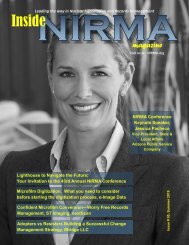Fall Inside NIRMA Issue
You also want an ePaper? Increase the reach of your titles
YUMPU automatically turns print PDFs into web optimized ePapers that Google loves.
<strong>Inside</strong><br />
Leading the way in Nuclear Information and Records Management<br />
magazine<br />
Visit us at: <strong>NIRMA</strong>.org<br />
2024 <strong>NIRMA</strong><br />
Board of Directors<br />
The Wonderful<br />
World of Microfilm<br />
On Site Capture<br />
(OSC) Projects<br />
A Call from the Past: Embracing the History<br />
and Future of Aperture Card Scanners<br />
<strong>Issue</strong> # 18, <strong>Fall</strong> 2023
CONTENT<br />
9<br />
12<br />
15<br />
16<br />
The Wonderful World of Microfilm<br />
By Kate Gleason, <strong>Inside</strong> Technical Sales Rep., nextScan/ST Imaging<br />
A Call from the Past: Embracing the History and Future of Aperture<br />
Card Scanners<br />
By Hannah Clawson, Communications Coordinator, The Crowley Company<br />
Introducing the 2024 Board of Directors<br />
On Site Capture (OSC) Projects<br />
By Manuel Bulwa, Integrated Scanning of America<br />
18<br />
19<br />
20<br />
28<br />
31<br />
This is “So Long!” Not “Goodbye”<br />
By Margie Janney, CRM/NS/FED, NRC<br />
Meet Helena Gilbert, NRC Agency Records Officer<br />
Symposium Pictorial<br />
Chronicles of NIM: A Retrospective on Information Management in<br />
Nuclear Power<br />
By Eugene Yang, KISMET Consulting, Inc.<br />
SIGET: Focused on Artificial Intelligence<br />
By Bob Larrivee<br />
2 <strong>Fall</strong> 2023 <strong>NIRMA</strong>.org <strong>Inside</strong> <strong>NIRMA</strong>
in every issue<br />
MESSAGE FROM THE BOARD—4<br />
SYMPOSIUM CORNER—6<br />
TREASURER REPORT—17<br />
PDBU NEWS—32<br />
M&MBU NEWS—33<br />
RIMBU NEWS—34<br />
INDUSTRY NEWS—35<br />
Letter from the Editors<br />
We at <strong>Inside</strong> <strong>NIRMA</strong>, value your opinion and are<br />
always looking to improve our magazine. Let us<br />
know what you like and dislike and what you’d<br />
like to see more of. Share your thoughts with our<br />
Communication Team at<br />
DevereauxInc@outlook.com.<br />
If you haven’t already done so,<br />
please take a moment to follow<br />
<strong>NIRMA</strong> on YouTube, X<br />
(formerly Twitter) and<br />
Instagram, like <strong>NIRMA</strong> on<br />
Facebook, and connect with<br />
<strong>NIRMA</strong> on LinkedIn.<br />
Thanks for reading. Please keep in touch!<br />
Neal and Sandra Miller<br />
Editors<br />
Editors<br />
Neal and Sandra Miller<br />
DevereauxInc@outlook.com<br />
Advertising<br />
Neal.F.Miller@gmail.com<br />
<strong>NIRMA</strong> Headquarters<br />
Sarah Perkins<br />
<strong>NIRMA</strong> Administrator<br />
nirma@nirma.org<br />
In addition to our own<br />
articles, <strong>Inside</strong> <strong>NIRMA</strong><br />
publishes guest articles from<br />
agencies and vendors. Please<br />
be advised that the views and<br />
opinions expressed in these<br />
articles are those of the<br />
authors and do not<br />
necessarily reflect the<br />
opinions of <strong>NIRMA</strong> or its<br />
Board of Directors.<br />
Back to Content | <strong>Inside</strong> <strong>NIRMA</strong> <strong>NIRMA</strong>.org <strong>Fall</strong> 2023 3
MESSAGE FROM THE BOARD<br />
A Wide Tent for <strong>NIRMA</strong><br />
L<br />
ooking back upon another great <strong>NIRMA</strong><br />
Symposium in August, we are thankful to all of<br />
you and the talents you bring to <strong>NIRMA</strong>. Those<br />
who attended are now officially <strong>NIRMA</strong> members, as<br />
we affectionally call "NIRMITES".<br />
<strong>NIRMA</strong> indeed offers a wide tent of interests and<br />
topics around regulated information management and<br />
nuclear power as we heard during the <strong>NIRMA</strong> 23<br />
Symposium. It became obvious that we are only in the<br />
infancy of what lies ahead. Our opening Keynote<br />
speaker, Ms. Erin Hultman, Nuclear Energy Institute<br />
(NEI) Vice-President, Member and Corporate Services,<br />
Chief Financial Officer) showed the way for a bright<br />
future for nuclear power. Then, Mr. Sadamaro<br />
Yamashita, Chairman of NRM Holdings provided an<br />
international perspective of Japan's nuclear power.<br />
Finally, we learned of the future potential from<br />
TerraPower on the third day's Keynote address provided<br />
by Mr. Eric Williams. What a fantastic opportunity for<br />
those in attendance to experience and to take back<br />
meaningful benchmarking to their own organizations!<br />
We celebrated our past with honoring the<br />
contributions of two great men with <strong>NIRMA</strong> Lifetime<br />
Member Awards to Bill Clover of Constellation Energy<br />
and Sadamaro Yamashita of NRM Holdings from<br />
Japan. What an honor it was to bestow the highest<br />
<strong>NIRMA</strong> recognition to two great members for decades<br />
of service to <strong>NIRMA</strong> and the nuclear industry.<br />
Congratulations!<br />
We look back on 2023 and are proud to say we<br />
advanced our <strong>NIRMA</strong> focus and Board Goals of:<br />
• Develop and maintain information management<br />
standards and technical guidance celebrating the<br />
likely final revision to the ANSI/<strong>NIRMA</strong> CM1.0-<br />
2007 (R2021), “Guidelines on Configuration<br />
Management for Nuclear Facilities” while seeing<br />
new guidance on the horizon for the industry.<br />
• Provide input to the hard copy and electronic<br />
records capture and retention in the context of<br />
ASME/NQA-1, “Quality Assurance<br />
Requirements for Nuclear Facility<br />
Applications.”<br />
Erin Hultman<br />
Sadamaro Yamashita<br />
• Research emerging technologies and assess how<br />
they will impact information and records<br />
management practices in the nuclear industry<br />
via the <strong>NIRMA</strong> Special Interest Group on Emerging<br />
Technologies (SIGET).<br />
• Provide educational and technical guidance for<br />
information and process management to our<br />
membership (via the Annual Symposium, Webinars,<br />
Mentoring Program, and Professional Certification<br />
Program).<br />
4 <strong>Fall</strong> 2023 <strong>NIRMA</strong>.org <strong>Inside</strong> <strong>NIRMA</strong>
Eric Williams<br />
➔ Bill Clover with<br />
<strong>NIRMA</strong> President,<br />
Janice Hoerber<br />
• Promotion of <strong>NIRMA</strong> to increase membership,<br />
vendor exhibitors, business unit participation,<br />
sponsorships, and social media presence.<br />
• Further develop relationships with commercial<br />
entities, government agencies, and industry<br />
organizations such as the NRC, DOE, NEI,<br />
ASME, CMBG, NITSL, and others.<br />
The post-Symposium survey was very positive,<br />
along with great thoughts and ideas for improvement<br />
in the next symposium. Thank you! We ALWAYS<br />
value your feedback and thoughts on what <strong>NIRMA</strong><br />
can do better to benefit its membership and to<br />
expand the <strong>NIRMA</strong> audience.<br />
The reality is that a long-standing organization<br />
such as <strong>NIRMA</strong> must continue to widen the tent of<br />
<strong>NIRMA</strong> interests, topics, and exhibitors. It benefits<br />
us all to acknowledge what is coming in the nuclear<br />
power industry and to lean in on what it means for us<br />
in the years ahead. Sometimes it is exciting and<br />
sometimes it is concerning if we are worried where we<br />
fit into the future workforce. Regardless, it is going to<br />
be quite a ride if we look at the future on a positive<br />
note and adapt to change and new technology. It<br />
might even be better. We may look back with a smile<br />
wondering how in the world did we exist with the old<br />
ways and tools that once were.<br />
Janice Hoerber and Bob Larrivee<br />
are concluding their <strong>NIRMA</strong><br />
Board of Director terms in 2023<br />
with gratitude and great regard<br />
for <strong>NIRMA</strong>'s mission. All things<br />
must come to an end, and indeed<br />
that time has come. <strong>NIRMA</strong><br />
serves the industry once again at<br />
a great time in nuclear power,<br />
just as it did in 1976. Information<br />
will become an asset much like<br />
plant assets, and that is core<br />
business for <strong>NIRMA</strong>!<br />
Enjoy the ride.<br />
Back to Content | <strong>Inside</strong> <strong>NIRMA</strong> <strong>NIRMA</strong>.org <strong>Fall</strong> 2023 5
By Bruce Walters, CRM/NS<br />
L<br />
ast year, the Board kind of chuckled at Bob<br />
Larrivee’s prediction that we will hit 150<br />
attendees at the 2023 Symposium. Heck, we<br />
had hardly surpassed 100 attendees in 2022 so that<br />
seemed like a big stretch. With a plethora of great<br />
speakers, brand-new topics being presented, and more<br />
vendors in 2023, we looked like we would do it. Then<br />
came company cutbacks and some people were forced<br />
to cancel their plans. In the end, we had 132<br />
attendees, but our Bob Nostradamus would have been<br />
accurate otherwise. For 2024, many of you there<br />
heard him predict 200 attendees. I’m not chuckling<br />
this time around.<br />
I am thankful for all the sponsors who financially<br />
supported this year’s symposium and our vendors for<br />
turning out. And, of course, to all of you who came<br />
and participated. We had five international attendees<br />
from Japan, Korea, and the United Arab Emirates.<br />
Plus there were 37 first-time attendees.<br />
And what a pleasure it was to bestow Lifetime<br />
Membership Awards to Mr. Sadamaro Yamashita<br />
and Bill Clover. Both are so deserving of this honor.<br />
You might take a moment to congratulate them both.<br />
What a great event! What great support all of you<br />
provided by turning out in volume. The speakers were<br />
awesome. There were topics that I didn’t even know<br />
existed. There were sessions that we had been<br />
pleading to hear about and they came to fruition this<br />
year. The Exhibitor Hall was filled with 12 vendors<br />
and an ICRM representative who sincerely enjoyed the<br />
crowd. And our Keynote Speakers knocked it out of<br />
the park. Our meals and receptions were fantastic and<br />
the Banquets staff at the JW Marriott are second to<br />
none!<br />
Next year, you are going to want to be at the 48 th<br />
Annual Symposium. I am eager for my next role on<br />
the <strong>NIRMA</strong> Board and know that your new Vice<br />
President, Kathi Cole, will have all the support in the<br />
world to take on this task. I have learned a lot as VP<br />
and plan to help Kathi put on an even better<br />
symposium next year. To conclude, in the wise words<br />
of Lou Rofrano … All the best!<br />
6 <strong>Fall</strong> 2023 <strong>NIRMA</strong>.org <strong>Inside</strong> <strong>NIRMA</strong>
37 First Time Attendees<br />
Board of Directors and the<br />
International Attendees<br />
Back to Content | <strong>Inside</strong> <strong>NIRMA</strong> <strong>NIRMA</strong>.org <strong>Fall</strong> 2023 7
nextscan<br />
industry's leading 3-in-<br />
r:2owerful r.iigr.i r:2roductior.1<br />
Microfiche<br />
I<br />
ELIMINATE MANUAL RECORD<br />
RETRIEVAL ONCE AND FOR ALL.<br />
FlexScan digitizes thousands of records in minutes!<br />
The Benefits of In-house Conversion are Clear:<br />
• A Low-Cost Alternative for High-Volume Film Conversionwith Fast and<br />
Professional Results.<br />
• Significantly Reduce Labor Costs. Increase Accessibility and<br />
Operational Efficiency with All Digital Record Retrieval.<br />
• Prevent Data Breaches and Maintain Confidentiality. Use Trusted Staff<br />
for Conversion of Proprietary Data.<br />
• Eliminate Risk of Data Loss. Preserve Critical Records that are Doomed<br />
to Degradation (Vinegar Syndrome).<br />
• Maximize Space and Save Money by Eliminating your Storage<br />
Footprint.<br />
Call us for a FREE Demo & Consultation! 208.514.4000<br />
208.514.4000 sales@nextscan.com www.nextscan.com Follow Us: 0 0 frD
The Wonderful World<br />
of Microfilm<br />
By Kate Gleason, <strong>Inside</strong> Technical Sales Rep.<br />
A<br />
s record managers, you have undoubtedly<br />
worked with some sort of microfilm, but do<br />
you know all the different types? Within the<br />
world of microfilm there are many film varieties. As<br />
printing technology changed and processes advanced, so<br />
did microfilm production. Depending on the need of<br />
the company or organization, formats and types ranged<br />
from standard to custom. Microfilm, for the most part,<br />
can be divided into type, size, and printing process. This<br />
article addresses some of the more common types of<br />
microfilm that can be scanned using nextScan’s<br />
FlexScan Multi-Format Production Microfilm Scanner.<br />
Roll Film<br />
ANSI cartridges, and<br />
Tuscan SnapLOCK<br />
cartridges. M-cartridge<br />
types are durable plastic<br />
cases with a round metal<br />
axis in the center. This<br />
axis has four holes<br />
aligned in an even<br />
square.<br />
ANSI Cartridges are<br />
plastic outer cases, also<br />
known as C-Clips. They<br />
wrap around the roll<br />
film so that a spindle<br />
will still slot into the<br />
opening in the reel.<br />
Tuscan SnapLOCK<br />
cartridges are similar to<br />
3M in that they are a full<br />
cartridge encasing the<br />
film. Unlike the 3M, the<br />
Tuscan SnapLOCK can use a spindle.<br />
Roll film reels are wound with strips of film, usually<br />
around 100ft to 200ft in length, with some reaching<br />
1000ft. These strips of film can come in a variety of<br />
widths and containers. The most common sizes of film<br />
are 16mm and 35mm. Within these sizes exist simplex,<br />
duplex, duo, and duo duplex layouts. The most<br />
common are simplex and duplex. That is, a singular<br />
frame along the strip (simplex) or two frames along the<br />
strip of film (duplex).<br />
Cartridge Film<br />
A subcategory of roll film would be roll film<br />
contained in cartridges. Cartridges serve the purpose of<br />
protecting roll film from external elements. The most<br />
common cartridges available are M-cartridge types,<br />
Blipped Film<br />
Continued on page 10.<br />
Back to Content | <strong>Inside</strong> <strong>NIRMA</strong> <strong>NIRMA</strong>.org <strong>Fall</strong> 2023 9
Continued from page 9.<br />
fiche are being scanned.<br />
Aperture Card<br />
Another type of roll film, blipped film, has indication<br />
marks below the frames for reading purposes. There can<br />
be up to three levels of blips. A single blip will be a<br />
consistent size while a double or triple blip will have<br />
small and large blips. The largest blip will usually denote<br />
a folder, larger blips will indicate the start of a<br />
document, while the small blips are read as pages within<br />
that document. There are also non-blipped frames<br />
which can serve a variety of purposes depending on<br />
how the reels were set up.<br />
Fiche<br />
Fiche are flat sheets containing multiple frames in<br />
columns and rows. These frames can be laid out either<br />
horizontally or vertically. Fiche, like roll film, comes in<br />
the common sizes of 16mm and 35mm, but can also<br />
contain more unusual sizes. The size of the film usually<br />
depends on the purpose of what is printed on the fiche.<br />
Common Fiche Sizes:<br />
• 105 mm x 148 mm – Standard<br />
• 105 mm x 148 mm- 105mm Fiche<br />
• 77 mm x 127 mm – Standard<br />
• 16 mm and 35 mm Mixed Jackets<br />
• 85.7 mm x 187.3 mm – Ultra Fiche<br />
• 76.2mm x 127mm - Mini Fiche<br />
• 117.5 mm x 148 mm - AB Dick<br />
• 127 mm x 203.2 – Jumbo<br />
COM Fiche, or Computer Output Microfiche, are<br />
fiche that were created by printing directly from a<br />
computer to a fiche creating a uniform appearance.<br />
Jacketed Fiche are fiche made with film strips or<br />
single frames that have been inserted into a protective<br />
sheet, or “jacket”. These sheets have multiple rows with<br />
one side open, making it easy to add or remove film to<br />
modify the fiche. Most film within a jacketed fiche are<br />
16mm, 35mm, or a mix of the two.<br />
As archives often have multiple formats, the FlexScan<br />
has been designed to handle multiple formats and sizes<br />
of fiche to make the process easy for any user. It also<br />
has an optional automatic fiche loader that can scan up<br />
to 720 fiche per hour, eliminating the need to hand feed<br />
and allow the user to audit the scans while additional<br />
An aperture card is aptly named as it consists of a<br />
card with a rectangular opening where a frame is<br />
mounted. The common sizes for these frames are<br />
35mm and 16mm. These can be either one-up or twoup.<br />
A two-up card will have two apertures vs. the oneup<br />
cards that only have one aperture.<br />
Hollerith cards are a form of aperture card with added<br />
Hollerith hole punches that contain information about<br />
what is displayed on the film. This information is usually<br />
also printed on the card itself.<br />
While the Flexscan can’t read Hollerith punches, it<br />
10 <strong>Fall</strong> 2023 <strong>NIRMA</strong>.org Back to Content | <strong>Inside</strong> <strong>NIRMA</strong>
can scan the information printed on the card, which<br />
often includes notes that were added after the initial<br />
creation of the card.<br />
Film can be<br />
further divided into<br />
the chemical<br />
processes used to<br />
produce it. These<br />
can be identified by<br />
color, as well as<br />
shine. There are<br />
pros and cons to<br />
each type and often<br />
the choice of which<br />
to use comes down<br />
to purpose, storage<br />
environment, and<br />
usage.<br />
Emulsion Types<br />
Silver Halide has<br />
a dull and shiny<br />
side to the film due<br />
to the chemical<br />
processes on each<br />
side. This is the<br />
clearest and most<br />
accurate form of<br />
film. However,<br />
silver halide can<br />
scratch easily,<br />
making handling and storage a delicate process. Most<br />
archives prefer this type of film for its accuracy and<br />
life expectancy if stored properly.<br />
Diazo film is shiny on both sides of the film and can<br />
vary in color from purple-black, blue-black, or brownblack.<br />
This color aids with contrast when light is<br />
applied for reading. As long as it’s not oversaturated<br />
and stored properly, the Positive Diazo Duplicate is<br />
one of the best films that allow for access, durability,<br />
and clarity.<br />
Vesicular film is considered semi-scratch resistant.<br />
The print is light blue in color and formed from<br />
bubbles between the film layers. Due to the fact it’s<br />
created with these bubbles, vesicular film can be<br />
ruined with heat, pressure, or fade with light exposure.<br />
In terms of quality, it’s similar to silver halide. It differs<br />
in that silver halide is resistant to light exposure but<br />
can be scratched easily, whereas vesicular film is<br />
scratch-resistant but susceptible to fading with<br />
exposure to light.<br />
Rewriteable film, as the name suggests, is rewritable.<br />
While this filming solution makes it easy to reuse and<br />
reprint, it’s also considered a short-term record<br />
solution and questionable when it comes to records.<br />
Jacketed fiche are considered part of this group as<br />
frames can be added or removed.<br />
With all the different microfilm types, finding the<br />
best solution for your archive can be overwhelming.<br />
Our FlexScan Multi-Format Production Microfilm<br />
Scanner offers multiple modules to make scanning any<br />
type of microfilm a breeze. At nextScan, we strive to<br />
find the best fit for our users to make conversion<br />
simple and frustration-free. If you’re struggling with<br />
your film collection or having trouble finding a<br />
solution to fit your needs, contact the conversion<br />
experts at nextScan to solve your microfilm issues.<br />
Back to Content | <strong>Inside</strong> <strong>NIRMA</strong> <strong>NIRMA</strong>.org <strong>Fall</strong> 2023 11
A call from the past:<br />
embracing the<br />
history and<br />
future of<br />
aperture card<br />
scanners<br />
I<br />
t all started when I<br />
received a voice<br />
message from Walter<br />
(Walt) Spicer, a former<br />
records management<br />
professional from Napa,<br />
California. In his short (but<br />
informative) message, he<br />
told me the story of his<br />
patent for a machine which<br />
Walter (Walt) Spicer<br />
created aperture cards and<br />
patented a machine<br />
asked if The Crowley<br />
for making aperture<br />
Company (Crowley) could<br />
cards in the 1960s.<br />
send an aperture card as a<br />
memento of his life’s work<br />
to pass along to future generations.<br />
This interaction sparked the realization that the<br />
motivation of Walt's request paralleled the purpose of<br />
aperture cards themselves: to preserve information<br />
beyond one human life. In this blog, we’re sharing a little<br />
of Walt’s story and how he and Crowley have<br />
independently been working to progress records access.<br />
Total ReCALL<br />
This wasn't Walt's first time connecting with Crowley.<br />
He had commented on a 2017 blog which discussed<br />
how aperture cards originated and became a favorite<br />
media for nuclear, engineering, aeronautics, naval,<br />
aerospace and other technical industries. If you’d like<br />
more background on the media, we recommend reading<br />
that blog first. The following information is based on<br />
what Walt shared with us in recent months.<br />
By Hannah Clawson,<br />
Communications Coordinator<br />
The Voicemail<br />
Aperture cards uniquely combined<br />
microfilm images and Hollerith punch<br />
data and were popular in insurance, title,<br />
engineering and nuclear records<br />
industries.<br />
“In 1960, I was employed by First American Title<br />
Insurance Company (First American) [in] Santa Ana, CA<br />
as assistant vice president of administration. We were<br />
working to build new title plants in California, Arizona<br />
and Utah,” explained Walt. “Title plants are databases of<br />
property records and contain a running history of real<br />
estate parcels in a specific county and vital transactions<br />
that are recorded daily for each parcel.” The plants<br />
include deeds, mortgage documents, liens and other<br />
information that title companies would need to ensure<br />
property ownership and provide adequate insurance.<br />
“For many years copying information into the plants<br />
was done by hand. In the 1940s, microfilming the<br />
courthouse records became the norm and 35 mm film<br />
readers were used to search the microfilmed county<br />
12 <strong>Fall</strong> 2023 <strong>NIRMA</strong>.org Back to Content | <strong>Inside</strong> <strong>NIRMA</strong>
ecords and duplicate records were added to the plants.”<br />
Walt continues, “Much later, IBM data cards [cards with<br />
punch data and no microfilm] were used to catalog the<br />
documents within each plant. The microfilm rolls<br />
containing the actual document images that would then<br />
need to be pulled from storage and the researchers<br />
would use viewers to search the records. The entire<br />
records<br />
pulling<br />
process was<br />
manual.”<br />
Walt<br />
helped to<br />
develop a<br />
mounting<br />
device which<br />
would a)<br />
increase the<br />
ability for<br />
those within<br />
the title<br />
plants to<br />
make their<br />
own aperture<br />
cards and b)<br />
facilitate<br />
faster<br />
records<br />
research by<br />
condensing<br />
all<br />
Copy of the First American newsletter<br />
announcing Walt’s invention of the<br />
aperture card creating machine.<br />
information onto one media, requiring fewer steps to<br />
access critical information. The machine was created in a<br />
shop in Costa Mesa, CA and punched a rectangular hole<br />
in the data card the size of a 35 mm film exposure. The<br />
microfilm was then viewed and cut to be attached within<br />
the hole or aperture of the card. The film was then<br />
secured it into the card with transparent Mylar adhesive<br />
tape.”<br />
Despite some testing and alterations to the mylar<br />
taping process, Walt’s concept stayed relatively the same<br />
throughout its use. The card design was patented and<br />
used by First American for many years. A First American<br />
newsletter published in May 1963 notes, "For the first<br />
time, users are able to make their own aperture cards on<br />
demand...The use of which results in large savings in<br />
engineering man hours."<br />
Many such mounting devices were made available in<br />
the years following, but to our knowledge Walt’s design<br />
was the first.<br />
From 1960 to 2023<br />
Crowley discontinued our aperture card creation<br />
services (formerly produced by our UK facility,<br />
previously known as Wicks and Wilson, Ltd.*) a few<br />
years back. Our aperture card creation services likely did<br />
not use Walt's design, nevertheless, we appreciate that<br />
someone with such a rich contribution to the media’s<br />
history contacted the Crowley team for help and we<br />
happily sent him a sample aperture card.<br />
While we no longer create aperture cards, Crowley<br />
still work intimately with the media both in<br />
manufacturing aperture card scanners and capturing<br />
them in our Digitization Services bureau. Crowley's<br />
latest aperture card scanner, the C400 Advanced, has<br />
made scanning this media an easier process while<br />
creating even higher image quality than ever before.<br />
Something to Call Home About: The<br />
New C400 Advanced<br />
Just as iPhones<br />
graduate to the<br />
next generation of<br />
technology, so do<br />
Crowley’s aperture<br />
card scanners.<br />
Released in late<br />
2022, the C400<br />
Advanced is the<br />
latest generation<br />
of aperture card<br />
scanner and<br />
utilizes what users<br />
love about the<br />
C400 and evolves<br />
it to the next level<br />
of efficiency,<br />
quality and ease.<br />
The Crowley C400 Advanced<br />
aperture card scanner, released<br />
to market in late 2022.<br />
Efficient: In addition to capturing both film and<br />
punch data simultaneously at high speeds (a key feature<br />
on the C400 as well), the C400 Advanced holds even<br />
larger batches of aperture cards (up to 300 cards) for<br />
automatic loading, scanning and unloading. These<br />
production features, paired with the scanner’s ability to<br />
output multiple end-use files from a single scan,<br />
contribute to the C400 Advanced impressive efficiency<br />
for records managers. The scanner’s batch scanning<br />
mode allows operators to use multiple scanners at once<br />
for even more performance.<br />
Continued on page 14.<br />
Back to Content | <strong>Inside</strong> <strong>NIRMA</strong> <strong>NIRMA</strong>.org <strong>Fall</strong> 2023 13
Continued from page 13.<br />
Image Quality: The clear difference between the<br />
two generations of C400 scanners is the enhanced<br />
image resolution. The C400 Advanced features a new<br />
high-resolution camera and uniform light source. We’ll<br />
just let the below images speak for itself on image<br />
quality.<br />
Grayscale images from the C400 (right) and<br />
the C400 Advanced (left).<br />
Ease of Use: The C400 Advanced software makes it<br />
easy for users of all familiarity levels to run production<br />
scan jobs with ease. Using templates allows the<br />
specifications of scan projects to be pulled up<br />
automatically and users can facilitate fast and consistent<br />
capture between different operators or over multiple<br />
workstations.<br />
Watch the new C400 Advanced in action in Crowley’s<br />
new video.<br />
Stop “Phoning In” Aperture Card<br />
Capture and Preservation<br />
Crowley’s sales teams have seen that many with<br />
aperture card collections just aren’t sure what to do with<br />
them, so their critical information goes untouched.<br />
Through digitization, vital records are preserved,<br />
accessible through easy-to-use digital files and physical<br />
copies are saved from degradation.<br />
In addition to manufacturing the new C400<br />
Advanced, Crowley Digitization Services – our awardwinning<br />
service bureau – has also employed the<br />
scanners in their aperture card scanning department.<br />
“The image quality is really what blew me away,”<br />
notes Crowley microform scanning project manager,<br />
Kristina Bane. “It’s magnificent. The speed<br />
enhancements and new design make a difference in our<br />
timelines too since scanners are easier to maintain, scan<br />
faster and need little-to-no downtime. Overall projects<br />
are taking less time to complete and are in better<br />
quality.” Using this new speed and efficiency, Crowley’s<br />
Digitization Services captures large aperture card<br />
collections faster than ever.<br />
“We’ve seen a remarkable difference in project speed<br />
and image quality,” bureau director Patrick Hill states.<br />
“Production speed has increased significantly, making it<br />
simple for us to digitize any size collection with a betterthan-expected<br />
turn-around time.”<br />
Preserving Aperture Card’s Long<br />
Legacy…With More to Come<br />
Crowley is honored to share Walt’s story and<br />
commend him for his contributions to innovating the<br />
media. We applaud his work in making this media what<br />
it is today and hope you enjoyed reading the retelling as<br />
much as we enjoyed writing about it.<br />
INTERESTED IN<br />
PRESERVING YOUR<br />
INFORMATION?<br />
If you have aperture card collections and are looking<br />
to convert records to digital copies, Crowley can help!<br />
Visit www.thecrowleycompany.com for a no-obligation<br />
demo, sample scan or quote!<br />
* Since acquiring Wicks and Wilson, Ltd. in 2011,<br />
Crowley has also manufactured aperture card scanners<br />
such as the C-Drive X (discontinued) and C400.<br />
14 <strong>Fall</strong> 2023 <strong>NIRMA</strong>.org Back to Content | <strong>Inside</strong> <strong>NIRMA</strong>
2024 <strong>NIRMA</strong><br />
BOARD OF<br />
DIRECTORS<br />
W<br />
e are proud to introduce <strong>NIRMA</strong>’s<br />
2024 Board of Directors and our<br />
Business Unit Directors and Co-Directors. This is<br />
a great team that will help lead our organization<br />
through 2024 and beyond.<br />
• President: Bruce Walters, CRM/NS,<br />
AECOM<br />
• VP: Kathi Cole, CRM, TFE, Inc<br />
• Secretary: Stephanie Price, Southern Nuclear<br />
• Treasurer: Tammy Cutts, PG&E Diablo<br />
Canyon Power Plant<br />
• Director of Infrastructure: Sheila Pearcy,<br />
CRA, Los Alamos Technical Associates, Inc/<br />
WIPP<br />
• Director of Technical Programs: Lou<br />
Rofrano, AMS Store & Shred<br />
2024 <strong>NIRMA</strong> Board of Directors (L-R): Lou Rofrano,<br />
Sheila Pearcy, Bruce Walters, Stephanie Price, and Kathi<br />
Cole. Inset: Tammy Cutts.<br />
2024 Business Unit Directors & Co-directors<br />
• Director: Stephen Fleshman,<br />
Cohesive Group<br />
• Co-Director: TBD<br />
Help<br />
WANTED<br />
• Director: Rhonda Redding,<br />
Evergy WCNOC<br />
• Co-Director: TBD<br />
• Director: TBD<br />
• Co-Director: TBD<br />
<strong>NIRMA</strong> is looking for members<br />
interested in becoming:<br />
• M&MBU Co-Director<br />
• RIMBU Co-Director<br />
• PDBU Director and Co-Director<br />
• Nominating Committee<br />
If interested, please contact<br />
the <strong>NIRMA</strong><br />
Office (nirma@nirma.org).<br />
Back to Content | <strong>Inside</strong> <strong>NIRMA</strong> <strong>NIRMA</strong>.org <strong>Fall</strong> 2023 15
ON SITE CAPTURE<br />
(OSC) PROJECTS<br />
By Manuel Bulwa, Integrated<br />
Scanning of America<br />
www.isausa.com<br />
A<br />
n organization planning to<br />
digitize a large volume of<br />
documents must decide<br />
between:<br />
• WHO: Engaging a professional<br />
service provider, undertaking it<br />
internally, or a combination of<br />
both.<br />
• WHERE: Executing the project<br />
on site client premises, or at the<br />
service provider’s plant(s).<br />
Due to editorial limitations, we will<br />
only focus on selected issues for on<br />
site capture (OSC) projects.<br />
Factors leading to a decision to<br />
capture on site may include security<br />
and privacy concerns, fear of losing<br />
control, mistrust around proper<br />
handling of documents (physically<br />
and operationally), liabilities,<br />
logistics, regulatory restrictions, and<br />
timely access to work in progress<br />
(WIP) documents.<br />
To contain anticipated risks and<br />
costs in OSC projects, close<br />
attention to details must be paid in<br />
areas such as:<br />
• WORK VENUES: Each<br />
production line frequently<br />
requires one desk space for<br />
scanning and two desks for<br />
prepping. Additional space may<br />
be needed for secondary<br />
scanners such as wide format,<br />
flat bed, overhead, transparencies<br />
and open track. Indexing, quality<br />
control (QC), workflow<br />
management, publishing,<br />
posting, etc., could be performed<br />
via remote access. Multiple<br />
production lines may be<br />
implemented to meet deadlines.<br />
Boxes need to be stacked in<br />
staging areas such as<br />
“RECEIVED”, “TO PREP”,<br />
“SET ASIDE”, “TO SCAN”,<br />
“SCANNED”, and “TO<br />
REMOVE”. The venue must<br />
provide clean power, adequate<br />
year-round HVAC, janitorial<br />
service, access at extended hours,<br />
a break room, surveillance,<br />
security, and Internet.<br />
• STAFFING: Onsite operators<br />
are likely to be local, clerical<br />
labor hired for the project, so it<br />
is important to address all<br />
formalities and legalities of<br />
temporary hiring, conduct<br />
background checks and careful<br />
interviews to secure protection<br />
against potential HR or labor<br />
union issues. Cell phones with<br />
cameras should be surrendered<br />
in a cabinet by the entrance,<br />
while phone calls may be<br />
handled wirelessly.<br />
• LOGISTICS: It is essential to<br />
implement robust check in-check<br />
out processes, box labeling,<br />
inventorying, transportation,<br />
logging, disposition, reporting<br />
and tracking of each box of<br />
documents. QC and production<br />
databases must always accurately<br />
sync with all logistical dynamics.<br />
Logs, status reporting, health<br />
codes and manifests should be<br />
available in real time. Boxes must<br />
navigate the workflow with<br />
unambiguous identity and<br />
profuse metrics. No box may be<br />
allowed to change custody or<br />
advance a workflow step without<br />
a thorough check of its QC<br />
health status.<br />
16 <strong>Fall</strong> 2023 <strong>NIRMA</strong>.org Back to Content | <strong>Inside</strong> <strong>NIRMA</strong>
• INDEXING: Capture<br />
projects usually involve multiple<br />
collections of documents, each<br />
with its own structure, filing and<br />
search methods and<br />
idiosyncrasies. Their physical<br />
filing methods provide a starting<br />
template to imitate when<br />
deciding the digital structuring<br />
and indexing for each collection,<br />
but this will soon get<br />
complicated as the parties<br />
negotiate digital indexing<br />
specifics. When humans search<br />
manually for a document, they<br />
browse through filing cabinets,<br />
drawers, folders, dividers, etc.,<br />
equipped with eyes, brains, hands<br />
and fingers that facilitate<br />
improvisation and visualization<br />
of details that make the search<br />
feasible. The digital counterpart<br />
seldom preserves the physical<br />
structure of originals (stapled sets<br />
for example, rarely get<br />
represented digitally, but do help<br />
when searching manually).<br />
Finding digitized records using<br />
only index data without a<br />
supplemental visual search could<br />
be frustrating. OCR, full text<br />
search and artificial intelligence<br />
(AI) may overpromise and<br />
underdeliver, but wherever<br />
feasible they are extremely<br />
powerful. Unstructured and semi<br />
-structured documents need<br />
thorough discussion,<br />
collaboration and negotiation<br />
between Subject Matter Experts<br />
(SME) from both sides.<br />
• COMMUNICATION,<br />
COLLABORATION:<br />
Clients possess subject matter<br />
expertise in their industry<br />
superior to that of service<br />
providers. Service providers<br />
must communicate and<br />
collaborate with the client SMEs<br />
to acquire and apply knowledge.<br />
Users should be enticed to freely<br />
experiment with various indexing<br />
and display structures of what<br />
would eventually be on their<br />
designated digital repository. An<br />
interim repository (sandbox)<br />
with special collaboration<br />
features will motivate users to<br />
experiment, annotate, flag,<br />
consult, approve and test<br />
changes without fear of doing<br />
damage.<br />
• QC: Every workflow step must<br />
be subject to strict QC.<br />
Remediation delays are costly,<br />
especially when originals are<br />
allowed to go too far down the<br />
workflow. Each workflow task<br />
creates profuse metrics that must<br />
be captured and thoroughly<br />
analyzed, crosschecked and<br />
logged.<br />
• CALCULATIONS: At risk<br />
of being accused of<br />
oversimplifying, I will throw<br />
round numbers to estimate<br />
timings and costs. The VENUES<br />
bullet (on the previous page)<br />
already addressed the issue of<br />
workspaces on typical business<br />
size paper documents. A typical<br />
production line requires 5 to 10<br />
man/hours of clerical labor for<br />
prepping and scanning, yielding<br />
at least 100 bankers boxes a<br />
month. Qualified labor for<br />
indexing, QC and remediation<br />
control is roughly estimated in<br />
one full time support (FTS) per<br />
line. Compute how many lines<br />
are needed to meet desired<br />
deadlines and calculate labor<br />
costs. Add one qualified FTS for<br />
overall project management and<br />
workflow control.<br />
Tammy Cutts, <strong>NIRMA</strong> Treasurer<br />
<strong>NIRMA</strong>’s Financial Holdings<br />
as of September 18, 2023<br />
Checking Account $143,495.74<br />
Debit Account $ 334.66<br />
Investment Account $ 91,622.25<br />
Back to Content | <strong>Inside</strong> <strong>NIRMA</strong> <strong>NIRMA</strong>.org <strong>Fall</strong> 2023 17
This is “So Long!”<br />
Not “Goodbye”<br />
B ack in 1992, as a contractor<br />
with the Department of Energy<br />
working on Yucca Mountain, a<br />
mentor suggested that I should go to<br />
the ARMA Conference or the<br />
<strong>NIRMA</strong> Symposium. Attending the<br />
1992 <strong>NIRMA</strong> Symposium in San<br />
Francisco was one of the best<br />
decisions I’ve ever made.<br />
What followed was a lot of work<br />
and a lot of fun.<br />
• Treasurer of the 1995<br />
Symposium in DC.<br />
• Writing a glossary.<br />
• The Electric Slide.<br />
• Hans, and joining the NQA-1<br />
Committee in his stead.<br />
• Karen & Eugene = “Paradise by<br />
the Dashboard Lights”.<br />
• Elected as <strong>NIRMA</strong> Treasurer<br />
and discovering the symposium<br />
contractor was not exactly<br />
aboveboard.<br />
• M&M Committee.<br />
• The Milwaukee SafeHouse.<br />
• How could anyone be as<br />
passionate about NARA as Steve<br />
Adams?<br />
• Our ANSI Standard. Jane<br />
Hannum always ensuring I had a<br />
Coke in the morning, even if the<br />
Board was staying in a Pepsi<br />
hotel.<br />
I could go on and on. The<br />
memories all center around people.<br />
You all.<br />
Since I’m retiring, I think I’m<br />
supposed to give you advice.<br />
• Get mentors. Many. There<br />
are never too many people in<br />
your life; some will become your<br />
best friends. Branch out to<br />
include good people who aren’t<br />
in your industry; you won’t be<br />
sorry.<br />
• Get involved, and not just<br />
at work or your professional<br />
organizations. You’ll make<br />
friends for life. (Hence, this is<br />
not a goodbye; you are my<br />
friends for life.)<br />
• Be kind. It is very true that<br />
people won’t remember what<br />
you said, but they will remember<br />
how you treated them. And treat<br />
yourself kindly, too. You can’t<br />
help others if you don’t help<br />
yourself.<br />
Margie Janney,<br />
CRM/NS/FED<br />
Some of my favorite quotes:<br />
• “You learn more about a<br />
person in an hour of play<br />
than in a year of<br />
conversation.”<br />
Plato<br />
• “What lies behind us and<br />
what lies before us are<br />
tiny matter compared to<br />
what lies within us.”<br />
Henry Stanley Haskins<br />
• “How lucky am I to have<br />
something that makes<br />
saying goodbye so hard.”<br />
Winnie the Pooh<br />
So long! I will see you again! If<br />
Meg Milligan’s retired boss (who I’d<br />
never met) can sit down next to me<br />
in a sidewalk café in Paris, I will run<br />
into you, also!<br />
18 <strong>Fall</strong> 2023 <strong>NIRMA</strong>.org Back to Content | <strong>Inside</strong> <strong>NIRMA</strong>
MEET HELENA<br />
GILBERT, NRC<br />
AGENCY RECORDS<br />
OFFICER<br />
W<br />
e are pleased to introduce<br />
Helena Gilbert, who is<br />
replacing Margie Janney’s<br />
involvement with <strong>NIRMA</strong> as the<br />
NRC’s <strong>NIRMA</strong> liaison. Helena will<br />
be a regular contributor to <strong>Inside</strong><br />
<strong>NIRMA</strong> offering updates and insights<br />
from the NRC.<br />
Helena is a native of Florida. She<br />
earned an Associates in Science degree<br />
from Miami Dade Community<br />
College and completed 129 hours<br />
towards a Bachelor’s in Science<br />
Degree in Business Administration.<br />
She also completed Executive<br />
Leadership training. She has earned<br />
the Certified Professional Secretary<br />
and Certified Records Analyst<br />
certifications in addition to a U.S.<br />
Navy Surface Warfare qualification.<br />
Helena served 22 years in the U.S.<br />
Navy retiring in January 2001. Her<br />
assignments on active duty included<br />
Florida, Alaska, Virginia, and<br />
Washington, D.C. She served on sea<br />
duty onboard the USS EMORY S.<br />
Land (AS-39). She enlisted as a<br />
Seaman, rising through the enlisted<br />
ranks to Senior Chief and then served<br />
as a Limited Duty Officer in<br />
Administration, ultimately retiring as a<br />
Lieutenant Commander.<br />
She has been a civil servant since<br />
October 2004. She has worked for<br />
the U.S. Navy, U.S. Marine Corps and<br />
the Federal Bureau of Investigation.<br />
She will be the Agency Records<br />
Officer at the NRC.<br />
She has been married to Mark for<br />
the past 36 years. They have two<br />
daughters, Jennifer and Amanda and a<br />
grandson, Jack.<br />
Margie Janney with OpenText Cybersecurity vendors<br />
Gil Brueckner presenting Fundamentals of Records<br />
Management.<br />
Back to Content | <strong>Inside</strong> <strong>NIRMA</strong> <strong>NIRMA</strong>.org <strong>Fall</strong> 2023 19
WELCOME RECEPTION
<strong>NIRMA</strong> would like to thank all the<br />
amazing Speakers!
A huge “Thank you” to all our Vendors.<br />
You helped make the <strong>NIRMA</strong><br />
Symposium a huge success.
C<br />
loud computing. The emerging world of<br />
harnessing the vastness of the Internet to<br />
access computing power and storage beyond<br />
your imagination. Running a computer model? More<br />
CPU, more RAM! Need to slam through hundreds of<br />
thousands of transactions in a single day? No problem!<br />
Want to store gazillion records ranging in size from 50K<br />
to hundreds of Mbytes? I’ll take a few terabytes, thank<br />
you very much!<br />
You have power of the universe in your very hands!<br />
But enough of the hype…<br />
By Eugene Y. Yang,<br />
Principal Consultant<br />
KISMET Consulting, Inc.<br />
I’ve been asked a lot lately about my take on the use of the cloud for the<br />
storage and management of electronic records pertaining to nuclear plant<br />
operations. I hope this issue’s column provides some clarity.<br />
Haiku on the Cloud<br />
The cloud, the promise<br />
No Infrastructure to keep<br />
Records protection?<br />
So, what’s cloud computing?<br />
Cloud computing is the delivery of on-demand<br />
computing services -- from applications to storage and<br />
processing power -- over the Internet, on a pay-as-yougo<br />
(“subscription”) basis. Cloud computing allows an<br />
organization to lease computer systems and services<br />
from computer service organizations. These<br />
organizations pool resources to serve multiple<br />
customers via the Internet, thus relieving the customers<br />
of buying, supporting, maintaining, and providing<br />
storage equipment and software themselves. Generally,<br />
the offerings consist of following types:<br />
• Infrastructure-as-a- Service (IaaS) - This<br />
type provides infrastructure resources, such as<br />
servers, network, operation systems, and data<br />
storage, from a location(s) where the services are<br />
provided to many clients on usually shared<br />
resources.<br />
• Platform-as-a-Service (PaaS) - This type<br />
provides frameworks that developers can use to<br />
build custom applications and deliver their<br />
applications over the Internet. PaaS provides the<br />
data serving, storage and management resources to<br />
the developer so they do not have to own the<br />
software and hardware and manage the technology.<br />
Like with IaaS, the customer is utilizing those<br />
resources as a service and relying on the PaaS<br />
vendor to maintain the equipment, software<br />
resources, security and technology.<br />
28 <strong>Fall</strong> 2023 <strong>NIRMA</strong>.org Back to Content | <strong>Inside</strong> <strong>NIRMA</strong>
• Software-as-a-Service (SaaS) - This type<br />
refers to cloud-based software that is hosted by a<br />
software vendor who provides the software service<br />
to multiple customers from shared datacenters of<br />
equipment and services. The shared data centers<br />
may or may not own the infrastructure being used<br />
by the software. For example, many of the SaaS<br />
software vendors use Amazon Web Services or<br />
Microsoft Azure to house their SaaS.<br />
What’s the compelling reason(s) for<br />
getting into it?<br />
Cloud-based services provide the opportunity to have<br />
improved business processes and/or potentially obtain<br />
a meaningful return on investment (ROI) when<br />
replacing nuclear facility-maintained server storage<br />
solutions. Potential benefits include subscription-based<br />
software fees, reduction of on-premise hardware,<br />
operating software, application software, database<br />
management, and content storage. Also, an<br />
organization can potentially re-target staff, as updates<br />
and upgrades hardware, software, and applications are<br />
addressed by the cloud provider.<br />
What should I look out for?<br />
• Functionality – It has to have the functionality<br />
that supports your document control and records<br />
management programs. Make sure the offering has,<br />
among others: electronic review and approval;<br />
controlling revisions and enforcing major and<br />
minor versioning; ability to apply security to<br />
different versions of a document (i.e. in-progress<br />
and superseded versions must have limited access);<br />
change package support; dynamic workflow; audit<br />
trail; annotations; a robust search engine for both<br />
metadata and content (text-readable); and able to<br />
view multiple file formats, such PDF, TIF, and<br />
perhaps even 3D diagrams.<br />
• Integration - Integrations with other plant<br />
information systems will occur and need to be<br />
thought through, especially when another company<br />
is hosting the cloud solution. Hosting companies,<br />
understandably so, need to limit what is installed on<br />
their servers and how outside applications push and<br />
pull information from their servers. The impacts<br />
need to be understood to prevent any surprises later<br />
in a project.<br />
• Security - There needs to be secure protection of<br />
data in transit and data at rest. “Data in<br />
Transit” (data in motion) is data actively moving<br />
across the Internet or through a private network.<br />
For cloud solutions, this protection is needed while<br />
data is traveling from network to network or being<br />
transferred to a cloud storage device. “Data at Rest<br />
“ is data that is stored on a hard drive, laptop, or<br />
archived/stored in some other way. With nuclear<br />
quality assurance records, protection at rest aims to<br />
secure inactive data stored on any device or<br />
network. Encryption can then be applied to secure<br />
data both in transit and at rest. For protecting data<br />
in transit, sensitive data is encrypted prior to<br />
moving and/or use encrypted connections<br />
(HTTPS, SSL, TLS, etc.). For protecting data at<br />
rest, encrypting sensitive files may occur either prior<br />
to storing them or encrypting the storage drive<br />
itself.<br />
• Environments - When moving from an onpremise<br />
application to the cloud, quotes by service<br />
providers typically limit the size of the nonproduction<br />
environments. When working in our<br />
industry, we typically require the test/QA<br />
environment to be of similar specifications to<br />
production. Understanding how non-prod<br />
environments are sized and any cost impacts to<br />
increase these environments in number or size<br />
should be understood upfront.<br />
• Emergency/disaster consideration - Vital<br />
records (e.g., procedures, critical control room<br />
drawings) need to be accessible and available in the<br />
event of a disaster and/or an Internet outage. Cloud<br />
backups and redundancy do not fulfill these<br />
requirements, as Internet unavailability is the issue.<br />
Because of this requirement, some hardware and<br />
software must be deployed on-premise. The cloud<br />
will not fully remove these dependencies.<br />
Continued on page 30.<br />
Back to Content | <strong>Inside</strong> <strong>NIRMA</strong> <strong>NIRMA</strong>.org <strong>Fall</strong> 2023 29
Continued from page 29.<br />
Is there a “dark side”?<br />
The following are some<br />
“watch outs” as you move into<br />
cloud computing:<br />
• Data breach (e.g., technical<br />
approaches; contractual<br />
“assurances”);<br />
• Use of third-party resources to execute;<br />
• Export control non-compliance;<br />
• Planned/unplanned outages (e.g., vendor outage,<br />
network outages; disaster recovery approaches/<br />
methods);<br />
• Loss of control of functional features;<br />
• Contractual issues (e.g., price increases when renew<br />
the lease, long lead time to renew); and<br />
• On-ramp and off-ramp terms and conditions (e.g.,<br />
data migrations into, and out of, the cloud service)<br />
[this is in the event that you choose to move the<br />
cloud solution from one service organization to<br />
another (or “back home”)]<br />
Where do I go from here?<br />
The Regulations and Information Management<br />
Business Unit (RIMBU) published WP07-22, “Cloud<br />
Computing Considerations” (October 2022), a white<br />
paper on cloud computing. More detail is provided on<br />
the types of cloud offerings, requirements, an evaluation<br />
process, going “hybrid” (some combination of cloud/on<br />
-premise computing), and more. For members, you can<br />
access it on the <strong>NIRMA</strong> website under “Reference<br />
Documents”. In there you’ll see a folder that contains<br />
our <strong>NIRMA</strong> White Papers.<br />
Will going to the cloud be all sunny and<br />
bright, or will it be dark and stormy?<br />
Eugene has been a member of <strong>NIRMA</strong> for over<br />
35 years, and served as President from 1999-2001.<br />
At the time he joined, <strong>NIRMA</strong> had only been in<br />
existence for 11 years. He would love to hear about<br />
stories and anecdotes from others, so please email him<br />
at eugene.yang@kismetconsulting.com.<br />
Eugene Yang and Rhonda Redding presenting VENI,<br />
VIDI, VICI: Wolf Creek Nuclear Generating Station Moves to<br />
the Cloud Part II<br />
vs.<br />
30 <strong>Fall</strong> 2023 <strong>NIRMA</strong>.org Back to Content | <strong>Inside</strong> <strong>NIRMA</strong>
siget:<br />
Focused on artificial<br />
intelligence<br />
t<br />
A<br />
t the Symposium this year, I<br />
presented a session titled<br />
“This plant is too big! This<br />
plant is too Small! This Plant is just<br />
right.” This session looked at the<br />
rapid changes now in progress,<br />
within the nuclear power generation<br />
segment.<br />
Gone are the days of having only<br />
large generators and plant facilities.<br />
In today’s world, and that of the near<br />
future, nuclear power generation for<br />
both government and commercial<br />
purposes presents growing<br />
challenges to the efficient, effective<br />
and accurate capture of vital<br />
information and records. Just think<br />
about the process of tracking a<br />
mobile reactor traveling cross<br />
country to a disaster site. What<br />
information is to be captured and<br />
how will that capture process work?<br />
There must be a greater<br />
understanding of the current data<br />
capture challenges, and there must<br />
be planning in a proactive sense<br />
rather than a reactive response. One<br />
discussion that arose from this<br />
session was related to the<br />
manufacturing of Small Modular<br />
Reactors (SMR) that could someday<br />
be manufactured in a factory,<br />
delivered to the site, and plugged in<br />
to begin operations.<br />
From a <strong>NIRMA</strong> perspective, this is<br />
where the Special Interest Group on<br />
Emerging Technologies (SIGET)<br />
serves the <strong>NIRMA</strong> community.<br />
SIGET was formed to investigate<br />
new technologies – like the new<br />
nuclear power stations – evaluate<br />
the impact this technology will have<br />
on information management<br />
practices and develop recommended<br />
white papers that present the<br />
technology and the considerations<br />
one might want to make note of in<br />
reaction to information capture and<br />
management.<br />
Additionally, SIGET works with<br />
other <strong>NIRMA</strong> business units to<br />
develop standards, and educational<br />
materials to be made available to<br />
<strong>NIRMA</strong> members. If you are<br />
interested in being part of SIGET,<br />
please contact:<br />
• Ron Hedges at<br />
r_hedges@live.com or<br />
• Stephen Fleshman at<br />
stephen.fleshman@cohesivegroup.c<br />
om.<br />
By Bob Larrivee,<br />
Board of Directors,<br />
Retired Purveyor of Process Automation<br />
The Rapidly Changing Nuclear Landscape<br />
Ron Hedges presents Assisting<br />
Litigation: Contributions IG and RIM<br />
can make to Favorite Outcomes.<br />
Not a <strong>NIRMA</strong> Member?<br />
Click here and join<br />
TODAY!<br />
Back to Content | <strong>Inside</strong> <strong>NIRMA</strong> <strong>NIRMA</strong>.org <strong>Fall</strong> 2023 31
Professional Development<br />
Business Unit (PDBU) News<br />
Lou Rofrano, PDBU Director<br />
S<br />
ummer is rapidly coming to a close and in<br />
the rearview mirror the very successful<br />
<strong>NIRMA</strong> 2023 Annual Symposium has<br />
concluded. So many great presentations and a host of<br />
returning members and most importantly a large<br />
number of first-time attendees. Like nuclear energy<br />
itself, with all of its new technology and advancement,<br />
we are seeing new members and new individuals<br />
entering Nuclear Records Management.<br />
As a result, the PDBU will be focusing much of its<br />
energy on the <strong>NIRMA</strong> Mentor Program in the back<br />
half of the year. Individuals who worked with our<br />
mentors found great benefit in the exchanges of<br />
professional knowledge and skills. In the coming<br />
weeks and months, you can look for some exciting<br />
additions and changes to the program, including:<br />
• Recruiting additional Mentors and Mentees<br />
• Revised topics of knowledge and skills sets based<br />
on your needs<br />
• Programs to support your professional<br />
development plans<br />
• Specialized communications for the newest<br />
<strong>NIRMA</strong> members<br />
• and more<br />
PDBU will also continue to provide updates on<br />
professional credentialing and certifications. We look<br />
forward to assisting your goals and development.<br />
Here is to a great finish to 2023 and an amazing<br />
2024.<br />
Scenes<br />
from the<br />
Symposium<br />
32 <strong>Fall</strong> 2023 <strong>NIRMA</strong>.org Back to Content | <strong>Inside</strong> <strong>NIRMA</strong>
MEMBERSHIP & MARKETING<br />
(M&M) Business Unit News<br />
Stephen Fleshman, M&MBU Director<br />
m<br />
&MBU is looking for members to help come<br />
up with fresh ideas to bring new members to<br />
<strong>NIRMA</strong>, as well as ideas of how to share<br />
everyone’s expertise with the membership. M&MBU<br />
meets the first Wednesday of every month for one<br />
hour at 12 p.m. CT. Please join us.<br />
Your Help Needed to Grow our<br />
Membership Via social media!<br />
Growing membership<br />
is a crucial focus to<br />
<strong>NIRMA</strong>. One of the best<br />
ways to reach new<br />
potential members is via<br />
social media. <strong>NIRMA</strong> is<br />
currently on four social<br />
media platforms and has<br />
its own YouTube<br />
channel. Here are each<br />
of the platforms along with the current number of<br />
followers:<br />
• Facebook - 656 followers<br />
• X (formerly known as Twitter) - 191 followers<br />
• LinkedIn - 136 followers<br />
• Instagram - 25 followers<br />
To improve our reach and performance on social<br />
media, we need your support. If you are not already,<br />
please follow us on one or more of these platforms.<br />
<strong>NIRMA</strong> posts regularly on these platforms. These<br />
posts include monthly communications, <strong>Inside</strong> <strong>NIRMA</strong><br />
magazine and information on upcoming events like the<br />
annual symposium. Having our members like, reply,<br />
and share <strong>NIRMA</strong> posts will dramatically increase the<br />
reach of these posts and demonstrate the value we<br />
provide to potential members.<br />
Looking for Nominating<br />
Committee Volunteers!<br />
<strong>NIRMA</strong> is currently looking for current<br />
members interested in serving on the Nominating<br />
Committee. The Nominating Committee is<br />
responsible for identifying candidates for next<br />
year’s Board of Directors election and will ensure<br />
that all appropriate supporting documents are<br />
received from each candidate.<br />
If you are interested in being a member of the<br />
committee, please contact the <strong>NIRMA</strong> Office<br />
(nirma@nirma.org).<br />
Back to Content | <strong>Inside</strong> <strong>NIRMA</strong> <strong>NIRMA</strong>.org <strong>Fall</strong> 2023 33
Regulations and Information<br />
Management Business Unit<br />
(RIMBU) News<br />
By Stephanie Price, RIMBU Director<br />
RIMBU 2023 Summer Meeting<br />
T<br />
he RIMBU team held our annual Summer<br />
meeting on August 10th following the<br />
<strong>NIRMA</strong> Symposium. The team spent time<br />
discussing several topics, including:<br />
• The Industry Foundation Class (IFC) for 3D<br />
Models white paper, which Rich Giska is<br />
authoring and will be ready for RIMBU review in<br />
October.<br />
• The combining of the four TGs on Electronic<br />
Records Management to which Eugene Yang has<br />
dedicated a great deal of time and expertise.<br />
• Valuable operating experience on Radiographs<br />
with ammonia syndrome and how Meg Milligan<br />
at Hanford addressed those issues.<br />
• How best to include new RIMBU members and<br />
get them familiar with our committee through a<br />
review of our policies and guidelines.<br />
Director and Co-Director Positions<br />
I am honored to have been elected to the 2024<br />
<strong>NIRMA</strong> board this year and I cannot thank the<br />
membership enough for their votes of confidence.<br />
Since I will be stepping down from my role as<br />
Director of RIMBU, I made a motion during the<br />
Summer meeting to nominate Rhonda Redding<br />
(Wolf Creek) for the Director role and she was<br />
confirmed by a vote of those in attendance.<br />
Congratulations Rhonda! With Rhonda accepting the<br />
role of Director, the role of Co-Director is now<br />
vacant. If you are interested in getting more involved<br />
with RIMBU or if you would like to nominate<br />
someone for the role of Co-Director, please reach out<br />
to Rhonda at Rhonda.redding@evergy.com.<br />
RIMBU is a great opportunity to benchmark with<br />
others in the industry, share valuable operating<br />
experience, and have the opportunity to influence<br />
industry standard guidance in records management. If<br />
you’re interested in getting involved, please reach out<br />
to Rhonda Redding at Rhonda.redding@evergy.com.<br />
34 <strong>Fall</strong> 2023 <strong>NIRMA</strong>.org Back to Content | <strong>Inside</strong> <strong>NIRMA</strong>
Nuclear energy has a proven track<br />
record of producing the clean and<br />
reliable energy communities need,<br />
while being an accommodating<br />
neighbor. As the most land-efficient<br />
source of energy, nuclear power<br />
plants require just 1.3 square miles<br />
per 1,000 megawatts of energy.<br />
With the next generation of<br />
technologies coming online,<br />
nuclear’s land usage may shrink even<br />
more. Many advanced reactor<br />
designs are poised to be simpler,<br />
smaller, and modular while creating<br />
good-paying jobs, enhancing our<br />
energy security, and helping us meet<br />
our climate goals. But did you know<br />
that some designs go one step<br />
further, providing resilient<br />
electricity...while being on a body of<br />
water?<br />
It may sound like science fiction,<br />
but it’s a fact that investors<br />
are expressing interest in floating<br />
nuclear power plants (FNPPs), and<br />
that nuclear-powered innovations<br />
have the potential to go seaborne. As<br />
a cutting-edge nuclear technology,<br />
FNPPs can address several global<br />
energy challenges with flexible<br />
power, innovation, and the ability to<br />
decarbonize heavy industries faster<br />
than you can say, “All aboard!”<br />
Spurring Versatile Power<br />
FNPPs allow for a wide range of<br />
versatile power applications.<br />
Developers construct them on ships<br />
or barges as self-contained, mobile<br />
power stations, ensuring they can<br />
deploy them to virtually any coastal<br />
region or waterway.<br />
This flexibility opens new<br />
possibilities for generating clean<br />
energy in areas that were previously<br />
inaccessible for traditional nuclear<br />
facilities. FNPPs can be an ideal<br />
solution to meet the specific energy<br />
demands of these regions, such as<br />
island nations that need energy for a<br />
wide variety of applications including<br />
water desalination, district heating/<br />
cooling, and electricity.<br />
Additionally, developers can build<br />
FNPPs with ready-made<br />
infrastructure like shipyards. By<br />
utilizing modular construction<br />
techniques to construct smaller,<br />
simpler reactors, developers reduce<br />
costs while paving the way for the<br />
quick deployment of nuclear power<br />
at sea.<br />
Decarbonizing Heavy Industries<br />
Addressing climate change will<br />
require significantly reducing our<br />
greenhouse gas emissions, especially<br />
from heavy industries that have<br />
historically relied on fossil fuels.<br />
FNPPs can be deployed near<br />
coastal industrial complexes,<br />
minimizing transmission losses and<br />
providing a stable power supply to<br />
energy-intensive operations. This<br />
localized power generation helps<br />
reduce the strain on existing power<br />
grids and assures a consistent energy<br />
supply to critical industries.<br />
Companies are also planning on<br />
deploying nuclear reactors on civilian<br />
maritime vessels for power and<br />
propulsion. Ocean transportation<br />
carries more than 80 percent of the<br />
world’s exported goods via large<br />
diesel engines. If these vessels were a<br />
country, they would be sixth globally<br />
on greenhouse gas emissions—just<br />
above Germany. Next-generation<br />
nuclear is the only zero-emission<br />
energy source available to power<br />
these vessels that make up the<br />
backbone of global shipping.<br />
Fostering Innovation<br />
This isn’t nuclear’s first time at<br />
sea—in fact, our nation has a rich<br />
history of using nuclear energy to<br />
Continues on page 36.<br />
Back to Content | <strong>Inside</strong> <strong>NIRMA</strong> <strong>NIRMA</strong>.org <strong>Fall</strong> 2023 35
Continued from page 35.<br />
support our naval operations.<br />
Though the technologies used by<br />
the Navy and proposed floating<br />
nuclear plants differ, they both<br />
showcase the innovation that the<br />
nuclear industry is known for.<br />
The United States developed the<br />
world’s first nuclear-powered<br />
submarine, the USS Nautilus, which<br />
first went to sea in 1955. In 1958,<br />
the Nautilus set another record<br />
when it became the first submarine<br />
to traverse under the North Pole.<br />
Six decades later, we now have<br />
the world’s largest nuclear-powered<br />
navy, which has traveled over 130<br />
million miles using nuclear power<br />
(enough to circle the Earth 3,500<br />
times!).<br />
From shaping the flexible energy<br />
systems of tomorrow, to advancing<br />
decarbonization across the<br />
economy, FNPPs are an innovative<br />
solution that can accelerate progress<br />
toward our climate goals. Learn<br />
more about how nuclear energy<br />
creates opportunities for industries<br />
to reduce or eliminate their carbon<br />
footprint —shaping a brighter<br />
future on land and at<br />
sea.<br />
Article reprinted with permission of<br />
NEI. Read full article here.<br />
Washington, D.C.—The Nuclear<br />
Energy Institute (NEI) has<br />
launched its first<br />
podcast, “Fissionary,” with debut<br />
guest Grace Stanke, a talented<br />
nuclear engineer and the reigning<br />
2023 Miss America. Hosted by<br />
Mary Carpenter and Jordan<br />
Houghton, the podcast aims to<br />
bring together diverse and<br />
compelling guests in conversations<br />
about how nuclear drives the world<br />
toward a cleaner and more<br />
sustainable future.<br />
Conversations in support of<br />
nuclear have grown louder among<br />
decision makers, government<br />
leaders, and energy enthusiasts.<br />
“Fissionary” aims to bring those<br />
conversations to communities and<br />
people who are searching for<br />
solutions to some of the most<br />
pressing issues we face today like<br />
climate and sustainability.<br />
In its premier season Houghton,<br />
NEI’s media relations lead, and<br />
Carpenter, who leads NEI’s content<br />
and digital strategy, set out to<br />
engage experts, researchers, and<br />
Grace Stanke, a talented nuclear<br />
engineer and the reigning 2023 Miss<br />
America<br />
influencers and explore some of<br />
today’s questions such as solving<br />
the climate crisis and securing<br />
energy independence through<br />
nuclear energy.<br />
The first episode, titled “Nuclear<br />
101 with Miss America,” is now<br />
available for streaming. Stanke joins<br />
Carpenter and Houghton to discuss<br />
her “origin story” that brings<br />
together pageants and nuclear<br />
power. The discussion explores how<br />
36 <strong>Fall</strong> 2023 <strong>NIRMA</strong>.org Back to Content | <strong>Inside</strong> <strong>NIRMA</strong>
Operations extended at Xcel Energy’s<br />
Monticello Nuclear Generating Plant<br />
until 2040<br />
In signing off on increased storage<br />
of spent nuclear fuel at Xcel<br />
Energy’s Monticello Nuclear<br />
Generating Plant, the Minnesota<br />
Public Utilities Commission (PUC)<br />
last week greenlit a further 10 years<br />
of operation at the site.<br />
NEI Launches New<br />
“Fissionary” Podcast, continued<br />
to become a nuclear advocate, the<br />
significance of advocating for<br />
nuclear energy, and the<br />
opportunities and challenges that lie<br />
ahead for the industry.<br />
With new episodes airing biweekly<br />
on Thursdays, "Fissionary” boasts<br />
an impressive lineup of guests,<br />
including well-known influencers,<br />
former anti-nuclear climate<br />
activists, leaders in sustainable<br />
fashion, and global policy experts.<br />
“Fissionary” is available to stream<br />
on popular platforms such as Apple<br />
Podcasts, Spotify, and Amazon.<br />
Please visit the NEI website for<br />
more information on each episode<br />
and featured guests.<br />
As a result, Monticello will<br />
be in operation until 2040.<br />
Together with Prairie<br />
Island Nuclear Plant,<br />
Monticello provides more<br />
than 30 percent of the<br />
electricity Xcels upper<br />
Midwest customers use.<br />
Last year, they provided<br />
nearly 14,700 GW hours of<br />
energy, and the company<br />
has labeled them critical to<br />
achieving a fully carbonfree<br />
electricity portfolio by 2040.<br />
“We thank the Commission,<br />
Minnesota Department of<br />
Commerce and other stakeholders<br />
for their careful review and<br />
recognition of the importance of the<br />
Monticello nuclear plant to our<br />
shared clean energy goals,” Chris<br />
Clark, president of Xcel Energy –<br />
Minnesota, North Dakota and South<br />
Dakota, said. “Nuclear power is<br />
crucial to achieving those goals<br />
because of its unique combination of<br />
reliability, affordability, and zero<br />
emissions.”<br />
Part of the reason these sites are so<br />
prized by Xcel is their regularity.<br />
They tend to operate even through<br />
extreme weather, shutting down only<br />
to refuel the reactors every two<br />
years. In recent years, Monticello has<br />
updated its efficiency and cut its<br />
operating costs by 35 percent over<br />
the past decade.<br />
Xcel also filed for an extension<br />
with the U.S. Nuclear Regulatory<br />
Commission, requesting an<br />
extension for the plant’s operating<br />
license at the federal level. A<br />
decision is expected in late 2024.<br />
Article reprinted with permission of<br />
NEI. Read full article here.<br />
Article reprinted with permission of<br />
DEI. Read full article here.<br />
Back to Content | <strong>Inside</strong> <strong>NIRMA</strong> <strong>NIRMA</strong>.org <strong>Fall</strong> 2023 37
<strong>Inside</strong> <strong>NIRMA</strong> Magazine is<br />
published three times annually.<br />
Click here to view past issues.


